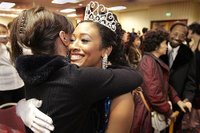
‘Crash’ question: Do blacks tip less?
By Jane Engle
Tribune Newspapers: Los Angeles Times
April 16, 2006
“That waitress sized us up in two seconds. We’re black, and black people don’t tip,” says Anthony, a character complaining about restaurant service in a scene from “Crash,” winner of this year’s best-picture Oscar.
That’s not just Hollywood talking, a Cornell University associate professor says: Research indicates that African-Americans, on average, leave smaller tips for servers than whites do and that they’re more likely to leave nothing.
Professor Michael Lynn’s latest report on this topic, “Race Differences in Tipping: Questions and Answers for the Restaurant Industry,” issued in January, cites more than 12 studies by himself and others, most done since 2002.
Discriminatory service may be a factor, but there appear to be many others.
Poor tips, Lynn says, may contribute to black diners getting poorer service and to companies’ reluctance to open restaurants in predominantly black communities, not to mention angering servers and customers alike. And it fuels yet another debate about tipping, always a hot-button topic for travelers.
Lynn doesn’t discount the role of anti-black bias in any of these problems. But he mainly sees this cycle at work:
Expecting skimpy gratuities, waiters resist serving African-Americans, or they provide poorer service, which discourages blacks from patronizing table-service restaurants. Low tips also make it hard for restaurants in black neighborhoods to attract and retain staff, causing turnover and decreasing profits.
Six years after Lynn, a respected expert on tipping at Cornell’s Center for Hospitality Research in Ithaca, N.Y., began to study the racial gap in gratuities, the topic remains taboo, he says.
“It’s a problem the industry knows about,” says Lynn, who is white. “But the big players with money are afraid to address the issue. They’re afraid of being labeled racist.”
In an e-mail response, the National Restaurant Association, an industry trade group in Washington, issued a statement saying it “commends” Cornell “for addressing disparities in consumer tipping behavior,” but it did not specifically address the question of race.
Sue Hensley, spokeswoman for the restaurant association, said the group hadn’t researched this issue.
But she said it offers cards to restaurants, for distribution to customers, that calculate 15 and 20 percent tips for bills of various sizes. When that range became customary is not clear, but it was recommended by travel magazines as early as the 1950s, according to the association.
Gerry Fernandez, president of the Multicultural Foodservice & Hospitality Alliance, a non-profit group in Providence, R.I., that promotes diversity, finds merit in Lynn’s findings.
“There absolutely is a perception that certain groups, African-Americans in particular, do not tip as well as whites,” says Fernandez, an African-American whose grandparents hailed from Cape Verde, an island republic off Africa.
Why black people may tip less is not clear.
Income disparities and discriminatory service may play roles, Lynn says.
But even when black and white customers are in the same socioeconomic class or rate the quality of service equally, he says, several studies by himself and others found that they tip differently. Black diners average 10.9 to 14.7 percent of the bill, and white diners average 16.6 to 19.4 percent, depending on the study. The server’s race didn’t matter.
Black subjects are also more likely than whites to say they never tip servers (6 versus 2 percent, in one study) and to leave tips as flat-dollar amounts instead of percentages of the bill (50.7 percent versus 19.4 percent, in one study).
Lynn thinks the main reason that African-Americans tip servers less is that most aren’t aware that the usual guideline is 15 to 20 percent of the bill. In one study, 35.9 percent of African-Americans identified that range as the norm, versus 72.4 percent of whites.
Research data don’t show why African-Americans may be less aware of the 15 to 20 percent guideline, Lynn added. But Fernandez and several black and mixed-raced diners I spoke with recently had no shortage of thoughts on this topic. They often cited economics.
Median household income for blacks in 2004 was 61 percent of that for non-Hispanic whites, according to the U.S. Census Bureau. And nearly a quarter of blacks lived in poverty in 2004, compared with 8.6 percent of non-Hispanic whites.
If you grow up poor, Fernandez said, you don’t eat out at fancy places--or at all.
“If you’re not exposed, how do you know the tip rules?” Kacey Towe, an image consultant of Creole descent, said between bites of peach cobbler at Harold & Belle’s in the Crenshaw district of Los Angeles.
She and her black dining companion tipped their waiter--an acquaintance of Towe’s--$20 on their $80 dinner bill, 25 percent, at the upscale Creole restaurant.
Not far away, in the Ladera Heights area, Stephaney Bell, dining with her son Steven, 14, at T.G.I. Friday’s, echoed the sentiments of several diners when she said, “A lot of black people can’t afford to tip as well.”
She also sounded another common theme: Some African-Americans base gratuities strictly on how they’re treated.
“Our expectations of service may be higher,” she said.
Bell, who travels and eats out frequently as sales auditor for an auto manufacturer, later tipped less than 15 percent because she was unhappy with the service.
A few tables away, Renee Davis, a black graphic designer, said, “A lot of white guys try to impress the table with a big tip. I’m not interested in impressing the table.” Contending that restaurateurs should pay more so servers don’t rely on gratuities, she said, “I have problems with 20 percent for a tip. I’m doing 15 percent.”
Fernandez sees other factors affecting tips too.
Some African-Americans may be “extremely sensitive” about service glitches, he said, such as getting their food late, after other tables are served, or being seated in the back. Such actions, whatever their intent, may be perceived as racial slights.
“Remember the back of the bus?” he said.
In addition, poor service motivated by bigotry may occur “way more than anybody wants to admit,” Fernandez said.
Not everyone, of course, agrees that African-Americans tip less. Several black diners I interviewed, in my unscientific sampling, said they thought they tipped the same as or sometimes more than whites.
Rip Rahman, service manager at T.G.I. Friday’s, who is of Bangladeshi descent, dismissed race as a factor in gratuities, saying, “As far as I can tell, it’s all about the service.”












































